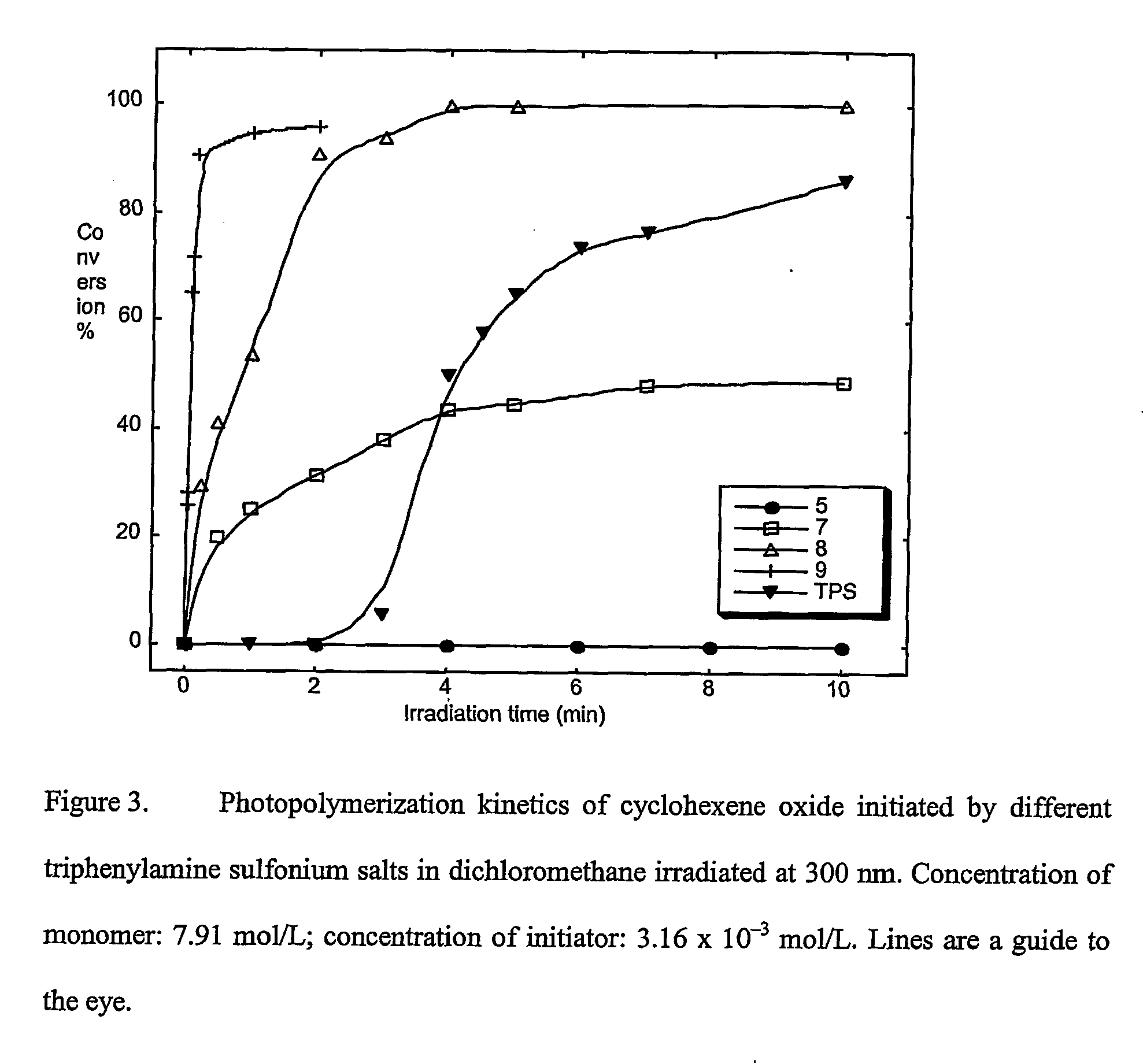Materials, methods, and uses for photochemical generation of acids and/or radical species
- Summary
- Abstract
- Description
- Claims
- Application Information
AI Technical Summary
Benefits of technology
Problems solved by technology
Method used
Image
Examples
example 1
[0266] Preparation of 3-bromothioanisole (1). 3-bromobenzenethiol (5 g, 26.44 mmol) was added to a solution of sodium methoxide (1.43 g, 26.48 mmol) in 20 ml of anhydrous methanol. The mixture was stirred for 30 min under nitrogen at room temperature and a solution of methyl iodide (4.51 g, 31.77 mmol) in 20 ml anhydrous methanol was then added. The reaction mixture was stirred overnight at room temperature, poured into 2 M aqueous NaOH solution (30 ml) and extracted three times with ether (60 ml×3). The combined organic layer was washed with saturated sodium chloride solution and dried over anhydrous magnesium sulfate. After removal of solvent, the product was purified by distillation at 80° C. (0.3 mmHg) and isolated in 86.1% (4.62 g) yield. 1H NMR(CDCl3, 500 MHz) δ ppm: 2.44 (s, 3H, CH3), 7.1-7.4(m, 4H, Ar—H)GC-MS(relative intensity %): 202, 204(1:1, 100, M+), 187, 189(1:1, 11, 3-BrPhS+).
example 2
[0267] Preparation of 3-bromophenyl benzyl sulfide (2). 3-bromobenzenethiol (5 g, 26.44 mmol) was added to a solution of sodium methoxide (1.43 g, 26.48 mmol) in 20 ml of anhydrous methanol. The mixture was stirred for 30 min at room temperature and a solution of benzyl bromide (4.53 g, 26.48 mmol) in 20 ml anhydrous methanol was then added. The reaction mixture was stirred overnight at room temperature, poured into 2M o aqueous NaOH solution (40 ml) and extracted three times with ether (60 ml×3). The combined organic layer was washed with saturated sodium chloride solution and dried over anhydrous magnesium sulfate. After removal of solvent, the product was purified by distillation at 161° C., 0.3 mmHg and isolated in 85.5% (6.31 g) yield. 1H NMR (CDCl3, 500 MHz) δ ppm: 4.12 (s, 2H, CH2), 7.0-7.5 (m, 4H, Ar—H)GC-MS (relative intensity %): 278, 280 (1:1, 30.8, M+), 91(100, PhCH2+).
example 3
[0268] Preparation of 3-methylthiotriphenylamine (3). 3-bromothioanisole (1) (2.0 g, 9.85 mmol) was added to a solution of tris(dibenzylideneacetone)dipalladium (Pd2(dba)3) (0.28 g, 0.306 mmol) and bis(diphenylphosphino)ferrocene (IPPF) (0.245 g, 0.442 mmol) in dry toluene (20 mL) under a nitrogen atmosphere at room temperature. The resultant mixture was stirred for 10 minutes. Sodium tert-butoxide (2.17 g) and diphenylamnine (1.67 g, 9.85 mmol) were then added and stirred at 90° C. for 24 h. The reaction mixture was poured into 20 mL of water, extracted three times with ether (3×60 mL) and dried over anhydrous magnesium sulfate. The product was purified by flash column chromatography using 2% ethyl acetate in hexanes as eluant to give 1.87 g of a pale yellow oil (65.2%). The product was estimated to be greater than 95% pure by 1H NMR and was used in next step without fiiier purification. 1H NMR (500 MHz, CDCl3) δ ppm: 7.25 (t, br, J=7.5 Hz, 4H), 7.14 (t, J=8.2 Hz, 1H), 7.08 (d, br,...
PUM
| Property | Measurement | Unit |
|---|---|---|
| Molar density | aaaaa | aaaaa |
| Molar density | aaaaa | aaaaa |
| Concentration | aaaaa | aaaaa |
Abstract
Description
Claims
Application Information
 Login to View More
Login to View More - R&D
- Intellectual Property
- Life Sciences
- Materials
- Tech Scout
- Unparalleled Data Quality
- Higher Quality Content
- 60% Fewer Hallucinations
Browse by: Latest US Patents, China's latest patents, Technical Efficacy Thesaurus, Application Domain, Technology Topic, Popular Technical Reports.
© 2025 PatSnap. All rights reserved.Legal|Privacy policy|Modern Slavery Act Transparency Statement|Sitemap|About US| Contact US: help@patsnap.com



